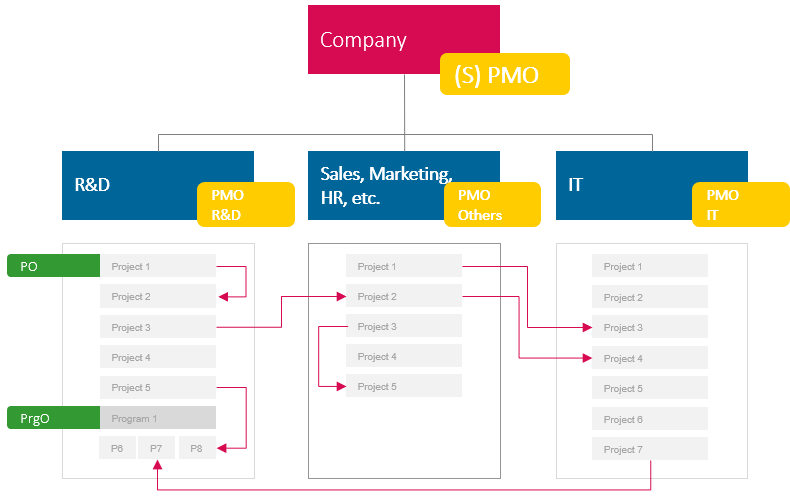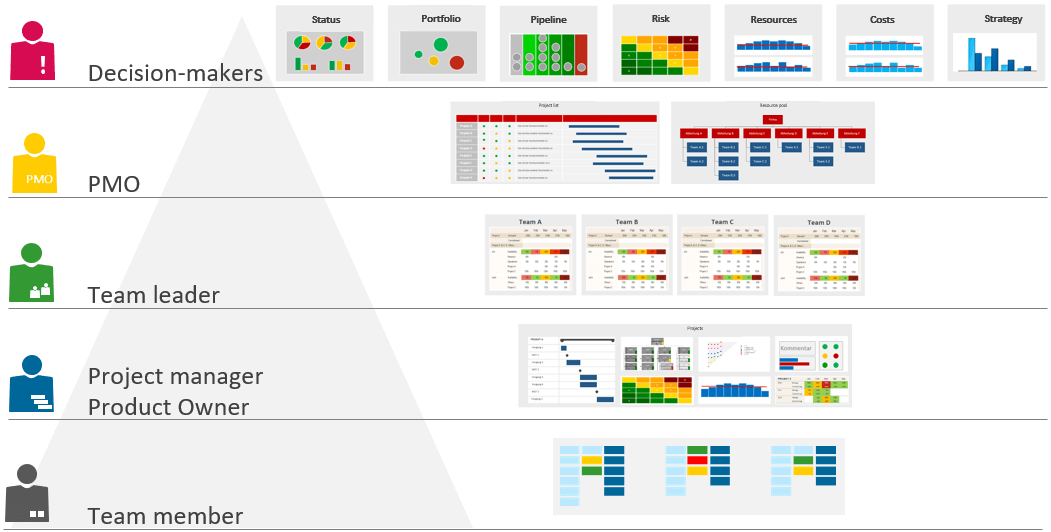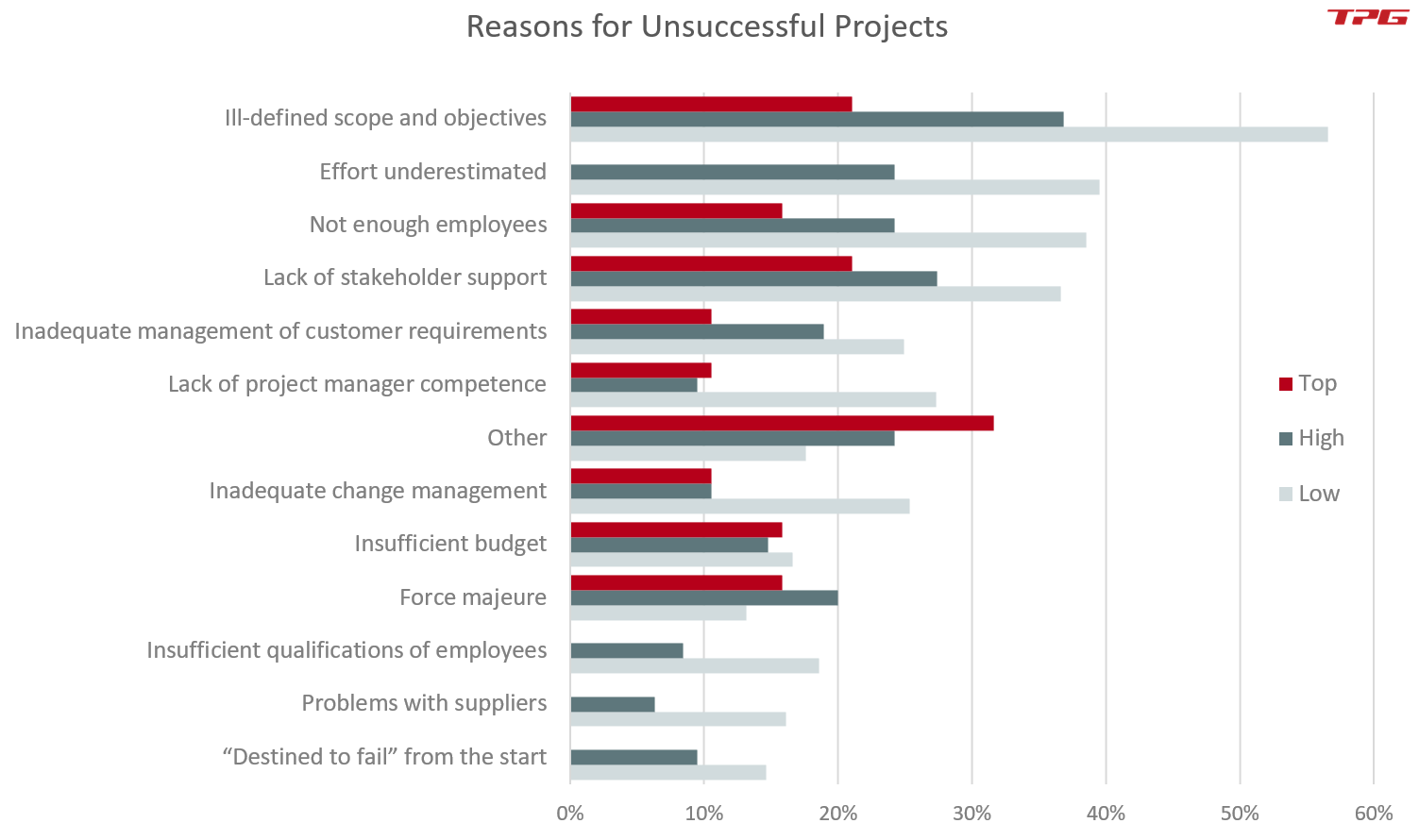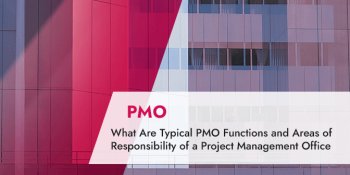Many companies operate a project management office (abbreviation PMO) already. Yet only very few of them have reached a state with which they are satisfied. No wonder, since merely setting up a PMO and letting it operate will not lead to sustained success.
On the other hand, the companies without a project management office are wondering about the benefits of a PMO or are looking for sound arguments to convince decision-makers. This series of articles is meant for both groups, with and (still) without a PMO. In this series including many practical tips, you will learn what you should know about setting up and improving a project management office.
This is the first page of a series of articles. If you are new to the topic, it will provide you with the PMO definition and a few basic answers to these frequently asked questions:
- What is a PMO? Definition?
- What is the difference between PMO and Project Office, etc.?
- Why have a PMO? When does a PMO make sense?
- What added value does a PMO provide? The PMO benefits
- What constitutes a good PMO?
- Conclusion and links to many other PMO topics
Let us begin with the definition and the distinction from the Project Office etc. After all, this is where confusion still exists.
What Is a PMO? Definition
A PMO is a centralized, permanent organizational unit that is responsible for handling multiple projects (multi-project management) for an entire company or department within the company. PMO functions may include, for example, training, project services, methodology, processes, and PM tools. A PMO may also have strategic duties, such as providing assistance in project portfolio management.
Distinction of PMO from Project Office, Program Office, and Project Assistance
| Responsibilities | Lifetime | |
| Project Management Office (PMO / sPMO) |
Entire multi-project environment of a company or a department within the company Strategic PMO (sPMO) helps with the control of the portfolio, prioritization, and strategy |
Designed for the long term |
| Project Office (PO) | Implementation of ONE big project Corresponds to a slightly more developed project assistance |
Only for the duration of the project |
| Program Office (PrgO) | Optimization of a program consisting of several projects dedicated to a common program objective | Only for the duration of the program |
| Project assistance | Support with operational and administrative tasks to reduce the workload of PMO, PO, PrgO | Dependent on assignment |

Companies with a multi-project environment involving various departments with interdependencies often have several PMOs (see graphic). Each project management office is responsible for the project management methodology and processes in their respective department.
- A PMO is traditionally part of an R&D department. Its goal is to better manage the development projects.
- IT departments often have a PMO as well, and this project management office works to ensure the success of IT projects.
- In sales and marketing departments, you will find project management offices more rarely. Often elements of projects vital to the company’s mission, such as R&D projects or IT projects, are handled here.
- In addition, there is sometimes also a strategic PMO with cross-departmental responsibilities. This project management office is linked to top management and may have broader responsibilities, such as those involving portfolio management and strategic implementations.
Why Have a Project Management Office? When Does a PMO Make Sense?
Experience has shown that having a centralized project management office is especially helpful in situations where:
- You need to manage numerous projects
- You have to coordinate resources involving various departments
- Reliable and up-to-date information is what you require for making decisions
- Your projects are happening in a variety of departments, but are interdependent and possibly have an international setup
- You need their ability to make decisions quickly because you are working in a dynamic environment
- Your reporting requirements are constantly growing because increasingly more people want more specific information
- Project expenses are becoming a more critical issue
- You need to determine the projects’ priorities and strategic contribution and take these into account
A project management office should be positioned in the company’s upper echelons. This has several advantages, among them that the right project-related information reaches top management and the key decision-makers.
Vice versa, it also helps ensure that the demands of the key decision-makers are communicated to everyone involved in, and affected by, the projects.
The appropriate roles, processes, and tools must be implemented to ensure that this happens.

The number of team members working in the project management office depends on the size of the project environment and the scope of its activities.
Special Download: How to setup a PMO in 4 simple steps (PDF file)
Please fill in the form.
* Required Fields | Data Protection
What Added Value Does a PMO Provide? The PMO Benefits
The PMO’s mission is to improve the processes in a multi-project environment. However, what is considered an improvement varies from company to company. So, the benefit of having a project management office is best described as:
The project management office therefore provides a degree of satisfaction in the multi-project landscape that would not exist without its efforts.
Here is a list of the possible arguments for having a PMO and the added value it provides. These give the stakeholders confidence in the success of the projects.
- Every project has a strategic focus (prerequisite: the project management office has a say in strategic issues related to the project)
- Every project is managed successfully (a legitimate demand, but one that is not always possible for every project)
- A greater degree of maturity in the company’s project management (through various measures for everyone involved in projects)
- Maximized project performance (i.e. R&D projects completed in a short time frame, which can provide a clear competitive advantage in many industries)
- Optimized use of resources (making the best possible use of the available staff resources when resources are scarce)
- Fewer missed deadlines, cost overruns, and excessive use of resources (for example, by providing the project manager with support in the form of training and methodology)
- Fewer project risks (for example, through lessons learned and a greater awareness of Risk Management in Project Management)
- Maximizing the company’s success via its ongoing projects
Sign up for our blog newsletter now and never miss another blog post.
What Constitutes a Good PMO?
A good project management office ensures that projects in a multi-project environment run as smoothly as possible. PMOs that can be classed as top performers are much better at providing the necessary framework for projects than low performers. This means they manage to meet deadlines, budgets and quality requirements much more often.
The PMO Survey conducted and published by TPG (in the German-speaking countries) revealed that top performers, by comparison, have significantly fewer problems with:
- Clear definition of scope and objectives
- Effort estimation
- Qualifications of employees
- Suppliers
- Projects that are destined to fail from the start
On the other hand, the first two points are the main reasons for unsuccessful projects with both low and high performers (see chart below).

Special Download: 10 Vital PMO Success Factors (PDF file)
Please fill in the form.
* Required Fields | Data Protection
Note: If you are looking for external support, find out about PMO consulting here as well as a method for PMO setup in 99 days.
Conclusion and Additional Articles Related to the Project Management Office
You are now familiar with the definition of PMO and know where the differences to other entities lie, e.g. project office, program office or project assistance. Furthermore, you have learned when and why you would need a project management office and what added value it can provide. You also know what distinguishes a good PMO, i.e. a top performer, from one at a lower development level.
Now, it is time to delve into the complementary subject areas. For this purpose, you will find links to the other articles in our series below.
- PMO Functions – What are Typical Areas of Responsibility of a PMO?
- 10 Vital Success Factors for a PMO
- Successful PMO Setup in 4 Simple Steps
- PMO Reports for Project and Portfolio Management
- PMO Tools for Successful Multi-Project Environment
- How to Create KPIs for the PMO – Using KPIs to Document PMO Success
- Why Projects Fail and How PMOs Can Prevent This
- PMO Benefits – Maximizing the Advantages and Acceptance
- Why Agile PMOs Are Comparable to Hummingbirds
-
PMO Interview on the COVID-19 Crisis & the Future Hold for Working from Home
Why are you are still without a project management office, or why is your PMO not working as well as you would imagine? We look forward to receiving your comment below.
 Johann Strasser
Johann Strasser
The certified engineer has been a managing partner at TPG The Project Group since 2001
After many years as a development engineer in the automotive and energy sectors, Johann Strasser spent a decade as an independent trainer and consultant in the field of project management. During his tenure, he also served as project manager for software projects in the construction industry and provided scheduling and cost management support for large-scale construction projects. At TPG, he applies his expertise in product development and consulting services for international clients. His special focus is on PMO, project portfolios, hybrid project management, and resource management. For many years now, he has shared his knowledge through presentations, seminars, articles, and webinars.
 Achim Schmidt-Sibeth
Achim Schmidt-Sibeth
Senior Marketing Manager
After earning his engineering degree in environmental technology, he gained many years of experience in project management through his work at an engineering office, an equipment manufacturer, and a multimedia agency. Achim Schmidt-Sibeth and his team have been responsible for marketing and communication at TPG The Project Group for many years now.







